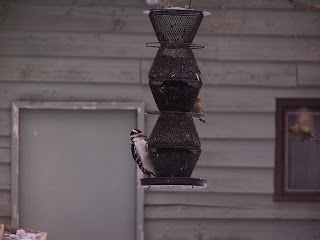It is spring, a time of transitions, rebirth, and new beginnings. As I was out skiing and hiking this evening, I had time to reflect on what some of those new beginnings have been in my life, and in history.
Growing up, one of the biggest transitions was the end of one school year, and beginning of something new. For many of the years, it was the beginning of summer vacation. My job in environmental education and tourism has me a lot busier in the summer as an adult.
In early June of 1996, I graduated from Roseville Area High School, started working my summer job, and prepared for college. April 30, 2000 was the day I graduated from Concordia College in Moorhead, and April 30, 2002, I arrived on the Gunflint Trail, and began my current job.
My chocolate lab Rudy was born on March 18, 2003, and my sister and I first met him five weeks later. I took him home (with my sister Jenni's help) when he was about six and a half weeks old. He was named after the main character in my favorite childhood novel. Rudy was my great companion for about 12 1/2 years. We had many great adventures together.
The first picture is of him the day I took him home. Rudy is seated behind a large snapping turtle (which he ran around on the trail) in the second photograph. The last picture of him was taken at Kakabeka Falls, Ontario the year that he passed away.
On May 5, 2007, the Ham Lake Fire was ignited. By the end of it, 75, 850 acres had burned, along with 147 structures. However, it was a huge rebirth for the forest. The plant life is extremely healthy right now, including the amazing blueberry crop. I haven't eaten half of the two gallons of blueberries that I collected and froze last year. They should last until the new crop is ready this year.
I took the picture of the pond off the Round Lake Road about 11 days after it had burned over. It was totally black right after it burned.
The other picture is of the back burn that they did on May 9, 2007. We were in reserve in the Cross River Gravel Pit, which gave me one of the few opportunities to take pictures of the incident. The red fire engine is still being used by our department.
It was in the spring of 2009 that Adam (local fishing guide and dog musher) and I went to Nashville. The recession was at its lowest point, and we got a little extra time off. I was thinking of taking a trip, and when I told Adam that I was thinking of going to Nashville, he said he would be interested in going along.
The main reason I was thinking of Nashville was that I was about to start being a substitute host for the Classic Country show on North Shore Community Radio (WTIP), and wanted to learn more about Country Music. We had a wonderful time, heard lots of great music, saw some great sites, and got a whole new appreciation for the Music City. I became one of the regular hosts of the Classic Country Show a few months after the trip.
 |
| Ryman Auditorium, Nashville, TN. Longtime home of the Grand Ole Opry. |
 |
| Country Music Hall of Fame, Nashville, TN. |
 |
| Piano inside RCA Studio B. Many of the great musicians have recorded here including Elvis Presley, Dolly Parton, and Charlie Pride. Elvis liked this piano so much that he tried to buy it from the studio, but they would not let it go. |
 |
| The late great "Little" Jimmy Dickens. He was 88 years old in this photo, and was the longest standing member of the Grand Ole Opry, having joined in August of 1948. |
Historically, there were some major milestones in space exploration in the spring. Yuri Gagarin became the first human to enter space on April 12, 1961. Alan B. Shepard became the first American to enter space that same year.
The American Civil War began on April 12, 1861. Robert E. Lee surrendered to Ulysses S. Grant in April of 1865. The Civil War ended completely in June of the year, and peace began.
The last three pictures were taken today. A white pine with the golden light of the sunset is the first picture. The other pictures are of the sunset from Lookout Point.
The snow is giving way to ice and bare ground. Soon buds will appear on the trees, and other plants will poke out of the ground. Birds have already began their spring migrations. Animals such as bears and chipmunks will be waking up from hibernation. In a month or two, the ice will leave the inland lakes, and it will be time for canoeing and kayaking.
I look forward to exciting new adventures this spring.


















































